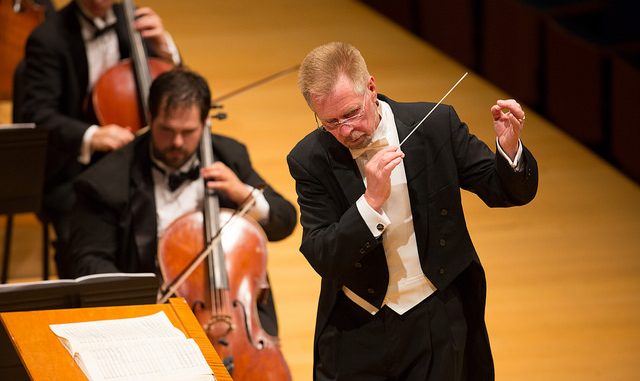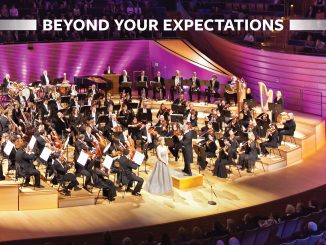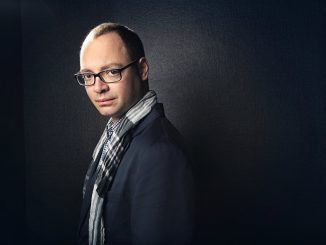
The UMKC Conservatory of Music and Dance Conservatory Orchestra is thrilled to present their final performance of the year in the Kauffman Center for the Performing Arts on Monday, April 24, 2017.
Joining the Conservatory Orchestra for this performance is student Xiangyu Zhao. Zhao was the alternate winner of the 2017 UMKC Concerto/Aria Competition, and will be performing Sergei Rachmaninoff’s Rhapsody on a Theme of Paganini, Op. 43. The Concerto/Aria competition is an exciting event for students and audience members alike, and the chance to perform as a soloist on the Helzberg stage is just one of the many wonderful experiences our Conservatory students have each year. Dr. Robert Olson, director of the Orchestra since 1990, is delighted to bring this popular work to audience members. “[This piece] is a very popular work with the public that’s a set of variations on a theme. One of the variations contains this super-romantic theme that has been used in countless romantic movies/settings in the middle of the piece. You can almost hear everyone in the audience ‘smile’ as they recognize this beautiful melody.”
Composed by Rachmaninoff in 1934, this work is a concertante, a mixture of the symphony and the concerto genres. In a concertante, the soloist is on display, much like in a concerto, but also a vital member of the total ensemble, such as in a symphonic work. Many Romantic Era and 20th-century composers employed techniques such as this, including Saint-Saëns (in his symphonic poem Danse macabre), Strauss (Don Quixote), Britten (Cello Symphony) and Prokofiev (Symphony-Concerto in E Minor, Op. 125). In Rhapsody on a Theme of Paganini, Rachmaninoff set 24 variations on the twenty-fourth and last of Niccolò Paganini‘s Caprices for solo violin, which has inspired works from several composers since its composition in 1817.
Paired with Rachmaninoff is a tone poem from German composer Richard Strauss, An Alpine Symphony. The story of An Alpine Symphony depicts the experiences of 11 hours spent climbing a mountain in the Alps, the highest and most extensive mountain range lying entirely in Europe. The excitement level for director Olson is high for this work. “I never thought I’d be able to conduct this incredible work on the university level because the work is incredibly demanding for every section of the orchestra and is a bit like running a marathon, as it is almost an hour in length. It musically tells the story of an ascent up some Alpine mountain, complete with waterfalls, thunderstorms, and mountain flowers. The work calls for a wind machine, the glorious Kauffman organ, and about an 80-piece orchestra on stage,” Olson added, “I can hardly wait!”
This piece, written in 1915, was the last tone poem from Strauss. Although this genre gained the composer popularity at the turn of the century, by the time he finished composing An Alpine Symphony, his attention had turned away from tone poems, and he was becoming well-established as one of the period’s greatest operatic composers. This piece is one of Strauss’ lesser-performed works for a number of reasons, including the great number of musicians required, and the demand it places on the orchestra members. Started in 1899, this work was originally titled Künstlertragödie (Tragedy of an Artist), but fell to the wayside as Strauss turned his attention to others. Some years later, after the 1911 death of his friend, fellow composer Gustav Mahler, Strauss returned to the work, writing in his journal:
“The death of this aspiring, idealistic, energetic artist [is] a grave loss … Mahler, the Jew, could achieve elevation in Christianity. As an old man the hero Wagner returned to it under the influence of Schopenhauer. It is clear to me that the German nation will achieve new creative energy only by liberating itself from Christianity … I shall call my alpine symphony: Der Antichrist, since it represents: moral purification through one’s own strength, liberation through work, worship of eternal, magnificent nature.”
Tickets to this exciting Conservatory Artist Series event can be purchased from Central Ticket Office by visiting http://umkc.edu/cto, or calling 816-235-6222. Tickets are $25 general public, and UMKC faculty, staff, and all students with valid UMKC or student ID are $10.




Leave a Reply
You must be logged in to post a comment.